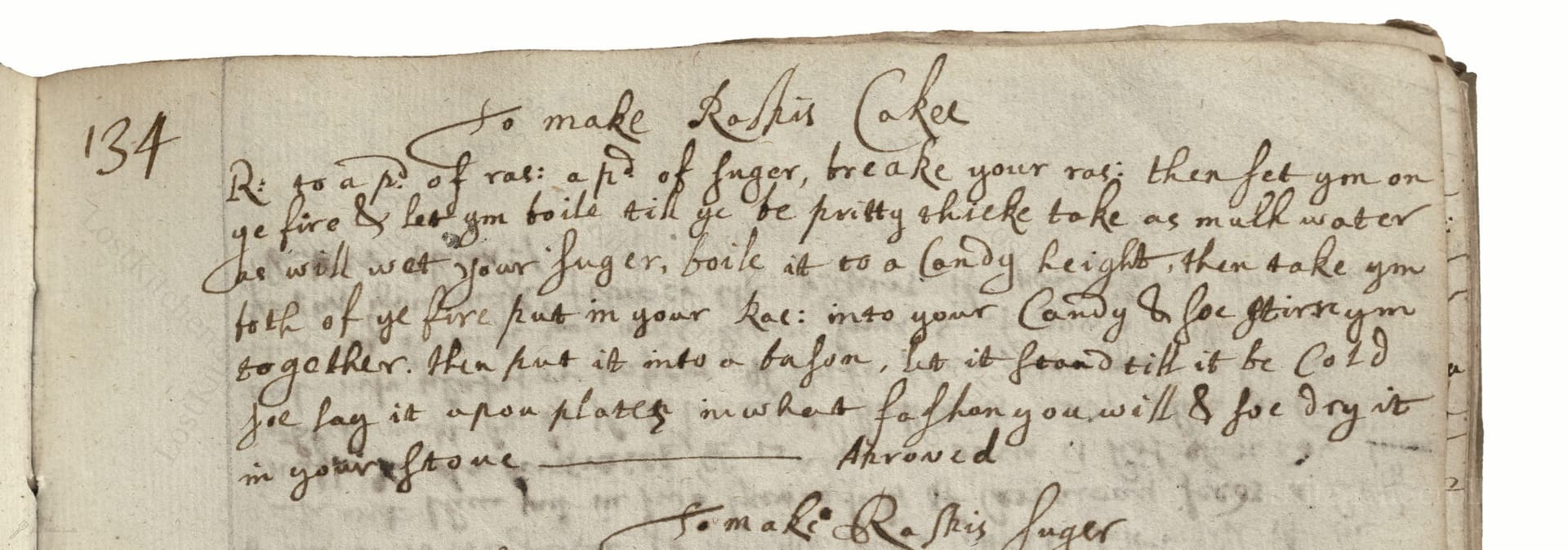To Make Rospis Cakes
From the treasured pages of Cookbook of L. Cromwell
Written by L. Cromwell

To Make Rospis Cakes
"R: goe a pd of ras: a pd of suger, breake your ras: then set you on ye fire & let ym boile till ye be pritty thicke take as much water as will wet your suger, boile it to a Candy height, then take you both of ye fire, put in your ras: into your Candy & soe stirr ym together. Then put it into a bason, let it stand till it be Cold soe lay it upon plates in what fashon you will & soe dry it in your stove. Aproved"
Note on the Original Text
The recipe is written in the brisk, abbreviation-heavy style common to early modern English manuscripts. Ingredients like 'ras:' refer to raspberries, and 'pd' means 'pound'. The method assumes basic kitchen knowledge, omitting details a modern recipe might clarify. Punctuation and spelling are fluid—'sugeer' for sugar, 'boile', 'ym' (them), and 'so' as 'soe'. Quantities and temperatures are loosely specified, relying on the cook’s experience to judge doneness—especially for boiling the sugar ‘to a candy height’. This reflects both the flexible orthography and practical kitchen knowledge of the day.

Title
Cookbook of L. Cromwell (1650)
You can also click the book image above to peruse the original tome
Writer
L. Cromwell
Era
1650
Publisher
Unknown
Background
Step back into the sumptuous kitchens of the 17th century, where L. Cromwell’s collection stirs up a medley of grand flavors and old English culinary traditions—a true feast for culinary historians and curious cooks alike.
Kindly made available by
Folger Shakespeare Library
This 'Rospis Cakes' recipe comes from an early 17th-century English household manuscript, compiled during the 1600s, a period when sugar work and fruit preserves started becoming fashionable among wealthier classes. The recipe reflects a time when imported sugar was a luxury, and fruits—especially berries—were preserved at summer's peak for enjoyment year-round. Such sweetmeats were prized for banqueting, a fashionable social custom amongst the gentry, and were served as delicate confections at the end of grand meals.

In the 17th century, cooks would have used a large brass or copper pot over an open hearth to boil the fruit. A wooden pestle or spoon was used to break up the berries, and a metal pan or small cauldron for boiling the sugar syrup. Cooking over coals or flame required skill in judging temperatures, as thermometers were rare or nonexistent, so the 'candy height' would be gauged by texture and appearance. The finished mixture would be spread on plates, and dried in a 'stove'—meaning a warm, dry room or a bread oven after baking had finished—sometimes on parchment or pewter plates.
Prep Time
5 mins
Cook Time
20 mins
Servings
16
We've done our best to adapt this historical recipe for modern kitchens, but some details may still need refinement. We warmly welcome feedback from fellow cooks and culinary historians — your insights support the entire community!
Ingredients
- 1 pound (about 16 ounces) fresh raspberries (or high-quality frozen if fresh unavailable)
- 1 pound (about 2 cups) granulated sugar
- 3 tablespoons water (enough to moisten the sugar)
Instructions
- To make Rospis Cakes today, start by taking 1 pound (about 16 ounces) of fresh raspberries and 1 pound (about 2 cups) of granulated sugar.
- Gently crush the raspberries and set them aside.
- Place the crushed raspberries in a saucepan and simmer over medium heat, stirring often, until the mixture thickens—this should take around 10–15 minutes.
- In a separate small saucepan, dissolve the sugar in just enough water (about 3 tablespoons) to moisten it.
- Bring this to a boil and heat until it reaches the 'soft-ball' stage (about 240°F/115°C), or until the syrup begins to thicken noticeably, akin to making candy.
- Take both syrup and raspberries off the heat.
- Pour the hot candy syrup into the raspberry mixture, stirring vigorously so they combine smoothly.
- Pour the combined mixture into a bowl and let it cool completely.
- Once cool, shape the thickened mixture into small discs or other desired shapes on a lined tray or plate.
- Allow them to air-dry in a warm place—a cool oven, dehydrator, or just on a rack covered with cloth—for several hours or overnight, until they become firm and set.
Estimated Calories
115 per serving
Cooking Estimates
Preparing and cooking Rospis Cakes only takes about 20–25 minutes. Most of the time is hands-on, with simmering and stirring. After mixing, you just need to let them dry until they set, which happens on its own.
As noted above, we have made our best effort to translate and adapt this historical recipe for modern kitchens, taking into account ingredients nowadays, cooking techniques, measurements, and so on. However, historical recipes often contain assumptions that require interpretation.
We'd love for anyone to help improve these adaptations. Community contributions are highly welcome. If you have suggestions, corrections, or cooking tips based on your experience with this recipe, please share them below.
Join the Discussion
Rate This Recipe
Dietary Preference
Main Ingredients

Den Bockfisch In Einer Fleisch Suppen Zu Kochen
This recipe hails from a German manuscript cookbook compiled in 1696, a time whe...

Die Grieß Nudlen Zumachen
This recipe comes from a rather mysterious manuscript cookbook, penned anonymous...

Ein Boudain
This recipe comes from an anonymous German-language manuscript cookbook from 169...

Ein Gesaltzen Citroni
This recipe, dating from 1696, comes from an extensive anonymous German cookbook...
Browse our complete collection of time-honored recipes



